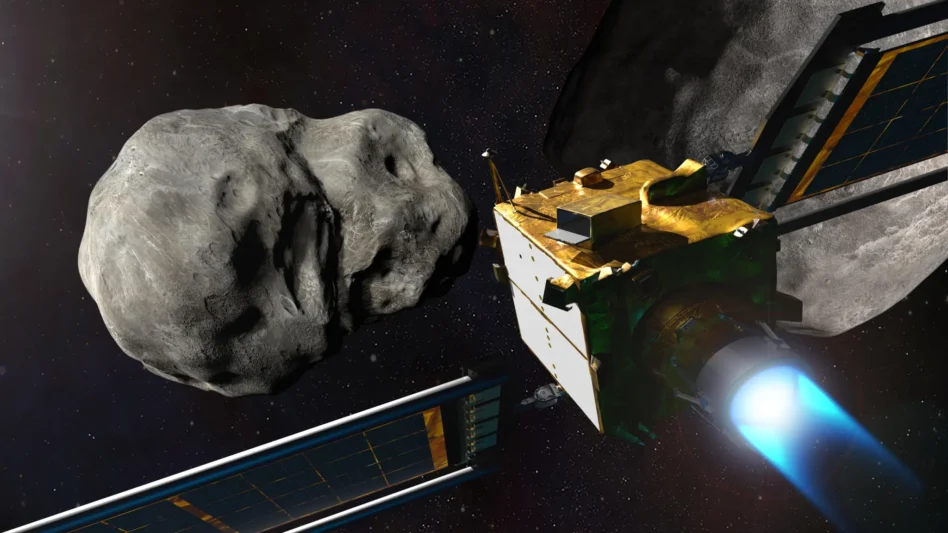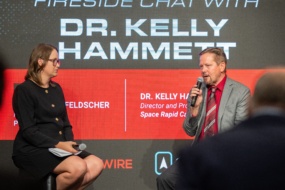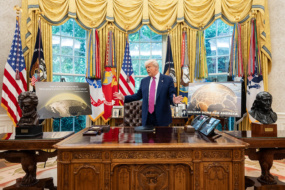NASA and academic officials will head to Capitol Hill this week to testify before Congress on what many Americans consider to be the agency’s top priority: making sure a giant asteroid whizzing through space doesn’t wipe out life on Earth.
The House space and aeronautics subcommittee will hold a hearing Thursday morning on NASA’s planetary defense strategy, including testimony from:
- Nicola Fox, NASA’s associate administrator of the science mission directorate;
- Amy Mainzer, a professor at UCLA who leads JPL’s NEO Surveyor mission;
- Matthew Payne, the director of the Minor Planet Center, located at the Harvard & Smithsonian Center for Astrophysics. .
What is it? NASA’s Planetary Defense Coordination Office, established in 2016 to manage ongoing planetary defense work, is charged with discovering, tracking, and (if needed) redirecting asteroids that may threaten Earth.
The office oversaw the Double Asteroid Redirection Test, or DART, which launched in 2021 on a one-way mission to intentionally collide with Dimorphos, an asteroid moonlet. The high-speed bump in 2022 successfully changed the path of Dimorphos, suggesting the agency could redirect an asteroid on a collision course with Earth.
The George E. Brown, Jr. Near-Earth Object Survey Act—which passed Congress as part of the 2005 NASA authorization bill—directed the space agency to find at least 90% of near-Earth objects larger than 140m (459 feet) in diameter, within 15 years of the bill’s passage. If you do the math, NASA is pretty far behind schedule—and learning how to catch up is a top question for lawmakers, according to the hearing charter. Members are also expected to dig into delays in the NEO Surveyor program that’s expected to help close the gap.
Top priority: Late last year, astronomers spotted a large asteroid, dubbed 2024 YR4, that was initially pegged with a 1% chance of hitting Earth in 2032. In February, as more observations of its pathway gradually came in, the probability of a serious Earth collision skyrocketed to 3.1% and then was revised down to .0004%. (While this is an extreme case of probability changes, such collision calculations often do change as our understanding of the space rock’s pathway improves.)
Lawmakers are wondering—how did this asteroid fly under the radar for so long?
“The public concern [2024 YR4] generated reminded us that planetary defense is not science fiction nor a distant curiosity, but a matter of national preparedness,” Rep. Mike Haridopolos (R-FL), who chairs the subcommittee, said in a statement. “With an estimated 14,000 hazardous asteroids still undetected and critical systems like NEO Surveyor facing delays, our responsibility is clear.”
Other questions: Lawmakers are also likely to ask about many other planetary protection priorities in the hearing, including:
- Budget: NASA’s planetary defense mission could “absolutely” face trouble under proposed budget cuts, according to one space policy source. It falls under NASA’s planetary science division within the science mission directorate, which is facing major cutbacks under the Trump administration’s “skinny budget” plan being considered by Congress.
- NEO Surveyor: The asteroid-hunting space telescope has been in progress for nearly 20 years. While that sort of timeline isn’t atypical in space, lawmakers will likely press for answers on why the telescope launch was delayed and what can be done to put it on track.
- Dark skies: Until NEO Surveyor launches, scientists will mainly rely on ground-based observations to find and track asteroids. This task is made more difficult by the rise of mega constellations such as SpaceX’s Starlink or Amazon’s Kuiper, whose bright satellites add complications for tracking faint objects in the sky.
- What’s next: Amid the sluggish government acquisition process, what happens if astronomers do find a life-ending asteroid heading Earth’s way? DART proved out kinetic tech, but it’s unclear if government and industry could rally to quickly build an impactor.
“If it takes 20 years to get through everything [for NEO Surveyor] how long will it take us if we need an impactor?” the space policy source said. “If we do discover a dinosaur killer…humans are squishy bags of water; it’s not great to get hit by big rocks.”




